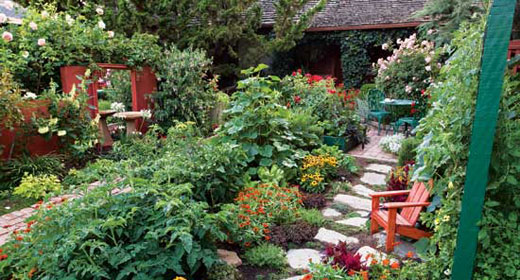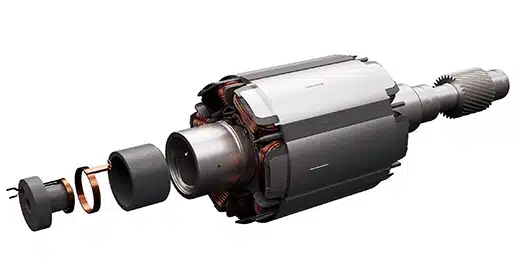by Linda A. Gilkson: Whether you grow food on a spacious homestead or are digging into your first urban garden,
ditching the plant-by-rows approach and instead adopting intensive gardening techniques can help you grow a more productive garden that’s also more efficient to manage. These methods will open up a new world when it comes to small-space gardening, which can be so much more than just a few lone pots on a balcony. If you do it right, you can grow more food in less space and put an impressive dent in your household’s fresh-food needs.
Comparing 2 Popular Intensive Gardening Methods
Two gardening authors and their systems of intensive vegetable gardening have been highly influential in North America for more than 30 years. Mel Bartholomew’s book on “square-foot” gardening was first published in 1981, while John Jeavons’ first book on “biointensive” gardening came out in 1974. Since these books hit the shelves, millions of gardeners have experimented with and embraced the gardening techniques advocated within.
Bartholomew’s aim with square-foot gardening is a simple, foolproof system that anyone can master (no companion planting, no crop rotation and no soil preparation). He prescribes raised beds of only 6 inches deep for most crops, filled with an artificial mix of peat moss, vermiculite and compost. While this method is reliant on assembling purchased components, it can work well in urban spaces, especially where soil contamination is a concern, where digging into the ground isn’t an option, or where people are especially picky about how a garden looks (perhaps because of ordinances for front lawns). Check out “10 Tenets of Square-Foot Gardening” below for more on this method.
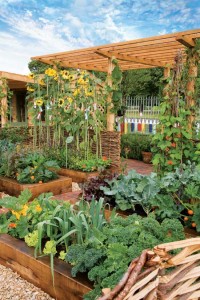 Jeavons’ biointensive gardening system is based on developing fertile soil in permanent garden beds that you initially dig to a depth of 2 feet. His primary goal is to grow food sustainably, using as few inputs from outside of the system as possible. He provides detailed instructions on crop planning, making compost, companion planting, crop rotation, growing crops that serve a dual purpose as food and compost-heap fodder, and more. See “10 Tenets of Biointensive Gardening” later in this article for the skinny on this system.
Jeavons’ biointensive gardening system is based on developing fertile soil in permanent garden beds that you initially dig to a depth of 2 feet. His primary goal is to grow food sustainably, using as few inputs from outside of the system as possible. He provides detailed instructions on crop planning, making compost, companion planting, crop rotation, growing crops that serve a dual purpose as food and compost-heap fodder, and more. See “10 Tenets of Biointensive Gardening” later in this article for the skinny on this system.
4 Principles of Intensive Gardening
Despite such differing approaches, both sets of techniques deliver high-yielding food gardens thanks to four common features, all of which I recommend.
1. Permanent garden beds. Establishing permanent beds enables you to concentrate your efforts only on where plants grow, without wasting compost or irrigation water on unplanted areas. It also makes soil compaction a nonissue, because you walk on permanent pathways and never on your growing areas. Setting up permanent beds and paths is such a popular layout here in the Pacific Northwest that I haven’t seen a garden arranged in rows for years. (Read more about the benefits of permanent garden beds in Care and Cultivation of Permanent Garden Beds.)
2. Reliance on compost. Both systems rely on the tried-and-true groundwork of all organic gardening: heavy doses of compost to supply balanced, slow-release nutrients needed to grow healthy crops. The organic matter in compost also increases soil’s water-holding capacity and improves its texture.
3. High-density mixed planting. A key to the high productivity of both systems is that they take advantage of the entire surface of each bed to grow plants rather than leaving spaces between rows. This results in even more yield without adding more garden space. For novice gardeners, Bartholomew’s method of marking off beds in 1-foot squares may be particularly helpful as a way to visualize how densely one can plant. Interspersing crops with different root depths, plant heights and growth rates also means you can grow more in a given space.
4. Prompt succession planting. Staggered planting and, thus, staggered harvests are more efficient for the gardener and maximize the growing season. Quickly replanting any gaps left after harvesting a particular crop lets you use every area of the garden throughout the year.
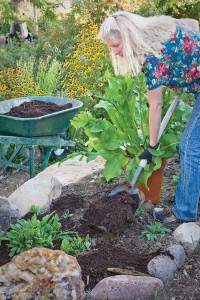 Customize Your Intensive Gardening System
Customize Your Intensive Gardening System
With fertile soil and dense planting, any garden can be highly productive — but as these two intensive-gardening approaches show, you can achieve this productivity via different means. I’m on Bartholomew’s side in favoring simple, low-maintenance methods (after all, the energy of the gardener is a valuable resource, too), but gardeners can learn much from Jeavons about sustainable practices. Reducing the use of nonrenewable resources — whether it’s fossil fuels burned in transporting supplies, irrigation water from deep aquifers or even peat moss — is an important consideration and one that’s on many gardeners’ minds. Square-foot gardening calls for purchasing a large amount of peat moss, which isn’t a renewable material. Coconut coir is a more sustainable option.
With time and experience, and based on the region and circumstances, every gardener tailors his or her system to what works best. I’ve talked with hundreds of gardeners over the past few decades to glean some of the commonalities between successful gardening systems, and the resulting recommendations that follow here will help you grow a high-yield but low-maintenance, sustainable garden.
Adapt to local conditions. Soil, climate, weather, water availability, composting materials, pests and diseases vary depending on where you live, so learn from local experts and look for information written for your region. (Connect with nearby gardeners on MOTHER EARTH NEWS’ new Facebook pages for each state and province.) The space you have available and the ease with which you can transport materials will also influence your gardening decisions. If you have a tiny urban garden, you aren’t likely to be able to grow a considerable amount of grain crops for supplying carbonaceous compostable materials, as Jeavons suggests doing. Creating nutrients and organic matter by making compost out of other ingredients, such as fall leaves and newspapers mixed with food scraps, may make more sense. For a large garden with more space, however, growing compostable or “green manure” crops may be the most practical way to build the organic matter in your soil.
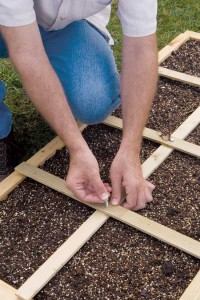 Go permanent. The effectiveness of using permanent garden beds is undisputed. Whether permanent beds should be raised, however, depends on the site and on personal preference. Raised beds — constructed with sides to allow the soil to be built up higher than the natural soil level — allow for good drainage on low-lying land and warm up quickly in spring. Older and less mobile folks could benefit from raised beds because they’re higher up and easier to work in. Gardens on well-drained soil, however, may fare better and need less water if the beds are not raised — and, of course, you won’t have the job and expense of building sides for your beds.
Go permanent. The effectiveness of using permanent garden beds is undisputed. Whether permanent beds should be raised, however, depends on the site and on personal preference. Raised beds — constructed with sides to allow the soil to be built up higher than the natural soil level — allow for good drainage on low-lying land and warm up quickly in spring. Older and less mobile folks could benefit from raised beds because they’re higher up and easier to work in. Gardens on well-drained soil, however, may fare better and need less water if the beds are not raised — and, of course, you won’t have the job and expense of building sides for your beds.
Use soil (if you have it). A con of Bartholomew’s system is that it relies so heavily on buying the ingredients to make your growing medium. This is expensive and means you aren’t using and improving the soil already on your property. Despite Bartholomew’s concern that improving soil takes too long, I’ve found that adding organic amendments, including balanced organic fertilizers if needed, can turn any soil into decent garden soil in its first few seasons. Generous applications of compost increase the nutrient- and water-holding capacity of sandy soils and improve the structure of clay soils. Regarding water conservation, plants growing in the ground usually need less irrigation than plants in containers or raised beds do, because soil-bound plants benefit from capillary flow of water from the subsoil. This upward movement of water can come from a depth of 2 to 8 feet, depending on the type of soil. Deep-rooted plants will also survive cold snaps and heat waves better than plants in containers and raised beds because their roots are subjected to less-extreme temperature swings. Of course, if your best sunny spot is a paved parking lot, by all means, build raised beds (the deeper, the better).
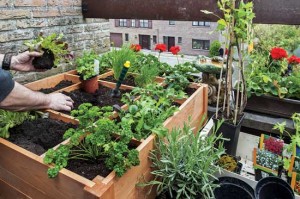 Be cheap. The first time I read Bartholomew’s book, I was struck by how expensive following his system to the letter would be, from the cost of building beds to buying and hauling a large volume of bulky materials for the growing medium — which he calls “Mel’s mix.” To me, the beauty of gardening is that it transforms waste material into tasty, nourishing food at a considerably lower cost than buying it. Compost can be virtually free if made from waste materials, such as grass clippings, leaves, manure, spoiled hay, and any waste from your garden, the grocery store or the food industry. Perhaps the ultimate in cheap fertilizer is “pee-cycling,” which merits wider acceptance for its effectiveness. (Go to Free, Homemade Liquid Fertilizers for more information on this method and other liquid fertilizer options.)
Be cheap. The first time I read Bartholomew’s book, I was struck by how expensive following his system to the letter would be, from the cost of building beds to buying and hauling a large volume of bulky materials for the growing medium — which he calls “Mel’s mix.” To me, the beauty of gardening is that it transforms waste material into tasty, nourishing food at a considerably lower cost than buying it. Compost can be virtually free if made from waste materials, such as grass clippings, leaves, manure, spoiled hay, and any waste from your garden, the grocery store or the food industry. Perhaps the ultimate in cheap fertilizer is “pee-cycling,” which merits wider acceptance for its effectiveness. (Go to Free, Homemade Liquid Fertilizers for more information on this method and other liquid fertilizer options.)
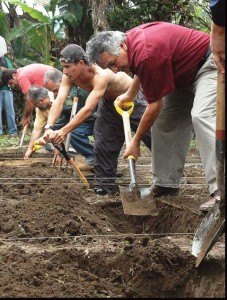 Don’t work too hard. When I initially encountered Jeavons’ book in the 1970s, I set out to follow his technique for double-digging my garden. I quickly discovered, despite Jeavons’ cheery instructions, that this was a daunting amount of work. When you finish shifting the soil, you will have moved all of the soil in the bed sideways by 1 or 2 feet and down to a depth of 2 feet. After digging one bed, I decided to skip the rest and live with the consequences — except none seemed to crop up. I saw no difference between the double-dug bed and the rest of the garden throughout that summer or in later years. Similarly, a 1998 study by Ohio State University found no significant yield difference between beans and beets grown in beds that had been cultivated only on the surface and beds that had been double-dug.
Don’t work too hard. When I initially encountered Jeavons’ book in the 1970s, I set out to follow his technique for double-digging my garden. I quickly discovered, despite Jeavons’ cheery instructions, that this was a daunting amount of work. When you finish shifting the soil, you will have moved all of the soil in the bed sideways by 1 or 2 feet and down to a depth of 2 feet. After digging one bed, I decided to skip the rest and live with the consequences — except none seemed to crop up. I saw no difference between the double-dug bed and the rest of the garden throughout that summer or in later years. Similarly, a 1998 study by Ohio State University found no significant yield difference between beans and beets grown in beds that had been cultivated only on the surface and beds that had been double-dug.
Over many years of intensive gardening, I have learned (as have many gardeners before me) that layering on mulches saves a lot of labor, and that minimal cultivation of beds works just fine. Research has provided sound reasons why minimizing soil disturbance is a good idea: Reduced-tillage systems result in higher populations of beneficial fungi that move nutrients and water through the soil column. Also, soils that receive less disruption have more beneficial nematodes, earthworms, soil mites and other microorganisms wriggling and crawling about. Neither Bartholomew’s artificial planting medium nor Jeavons’ repeated double-digging takes full advantage of such hardworking critters.
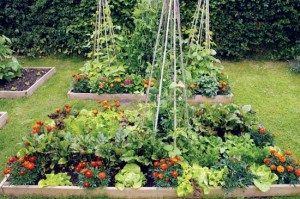 Because earthworms, plant roots and soil insects are so good at aerating soil, I’m happy to leave it to them. Without turning over the soil, I lightly fork compost and other amendments into the top couple of inches once a year, which takes me about 15 minutes for an 8-by-4-foot bed. For the rest of the season, I plant without cultivating, allowing easy interplanting by slipping in new plants between maturing crops. I often leave crop residues on the soil as a mulch and plant right through it. Creating minimal disturbance has led to a bountiful garden with less work on my part. This can, however, require a slight shift from the “clean soil” garden aesthetic some value.
Because earthworms, plant roots and soil insects are so good at aerating soil, I’m happy to leave it to them. Without turning over the soil, I lightly fork compost and other amendments into the top couple of inches once a year, which takes me about 15 minutes for an 8-by-4-foot bed. For the rest of the season, I plant without cultivating, allowing easy interplanting by slipping in new plants between maturing crops. I often leave crop residues on the soil as a mulch and plant right through it. Creating minimal disturbance has led to a bountiful garden with less work on my part. This can, however, require a slight shift from the “clean soil” garden aesthetic some value.
Weeding is, for most, a dreaded task, but it can be almost eliminated by smart planting. Intensive planting suppresses weeds, as the leaves of nearby plants quickly fill in and shade the soil. Using mulch to keep the soil covered is effective at smothering germinating weed seeds. I leave mulch on the soil for as much of the garden season as possible (weeds grow all winter in my Northwest climate), but I pull it back in spring to allow the soil to dry out and warm up. You can control weeds in pathways by laying down cardboard, newspaper or other light-excluding materials, or sow the pathways to grass or clover and mow (or scythe) them every now and then. Put the clippings back on the garden beds as a nitrogen-rich mulch.
Making compost can be as simple as putting everything in a bin, waiting for a season to pass, and then spreading the most digested material on the garden and returning undigested material to the bin. Or, don’t make compost at all: Just leave organic material on the soil to decompose. Any plant material, including crop residues and pulled weeds, will impart organic matter as soil organisms break it down. Roots are another source of organic matter, so instead of pulling plants when clearing a bed, I cut them at the soil line and leave the roots to decompose.
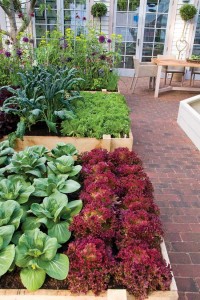 Keep it simple. My eyes glaze over when I see equations and complicated charts in a gardening book, and Bartholomew’s and Jeavons’ books aren’t short on either. While I generally vote for skipping overcomplicated and prescriptive planting advice, I do think keeping basic gardening records is useful. They don’t need to be elaborate, but recording when and what you plant, harvest dates, and notes on pest problems is a good idea so you have this information and can make well-informed adjustments when you plan next year’s garden. (To keep such records digitally, try the MOTHER EARTH NEWS Vegetable Garden Planner.)
Keep it simple. My eyes glaze over when I see equations and complicated charts in a gardening book, and Bartholomew’s and Jeavons’ books aren’t short on either. While I generally vote for skipping overcomplicated and prescriptive planting advice, I do think keeping basic gardening records is useful. They don’t need to be elaborate, but recording when and what you plant, harvest dates, and notes on pest problems is a good idea so you have this information and can make well-informed adjustments when you plan next year’s garden. (To keep such records digitally, try the MOTHER EARTH NEWS Vegetable Garden Planner.)
Ignore the bewildering number of gardening rules and myths floating around the Internet and other sources. For example, companion-planting charts of the “tomatoes love basil” variety are largely myth, though the value of planting to cycle nutrients to different crop families and attract beneficial insects is well-established (go to Maintain Healthy Soil With Crop Rotation for more). In my experience, you can safely disregard most crop-rotation systems, because relatively few crops in a diverse food garden are likely to suffer from soilborne diseases or pests. After you know what problems occur in your region, you know which crops to rotate. Where I live, for example, the high risk of root disease in the onion family and for potatoes makes four-year crop rotations smart for these, but I don’t worry about allowing long rotations for other vegetables.
Relax and smile. Gardens should be individualistic and fun. They can be as tidy or as wild as you like, take little effort to maintain, and still produce an astonishing amount of food from a small area. If digging beds, turning compost or setting up growing boxes works for you, carry on — just don’t think any of it is a strict requirement for a bountiful garden. Personally, I figure the less time and effort it takes to grow food, the more time there is to enjoy it!
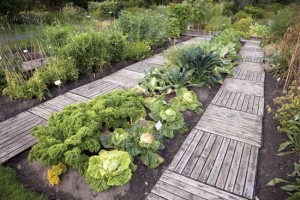 10 Tenets of Square-Foot Gardening
10 Tenets of Square-Foot Gardening
1. Cultivate in small, raised garden boxes that are at least 6 inches deep, separated into a 1-by-1-foot grid pattern (often 16 squares per box).
2. Fill boxes with a growing medium made of one-third peat moss, one-third vermiculite and one-third blended compost.
3. Intensively plant a prescribed number of each crop you choose to grow into each grid space, depending on plant size. (See Bartholomew’s book for the prescribed numbers. For example, plant one broccoli per square and plant 16 carrots per square.)
4. Sow only the number of seeds needed in each square to avoid wasting seed.
5. Add no fertilizer; rely on the compost in the growing medium for nutrients.
6. Practice low-maintenance gardening, with no digging, tilling, soil prep, soil testing or cultivating.
7. Achieve staggered harvests with succession planting.
8. Capitalize on vertical space by growing vining crops on supports.
9. Leave wide aisles (at least 3 feet wide) between your growing boxes to easily work in your beds and maneuver between them.
10. Employ tools minimally — you should only need a trowel for transplanting, a pencil for poking holes and lifting seedlings out of pots, and scissors for harvesting.
10 Tenets of Biointensive Gardening
1. Loosen soil in raised-bed planting sites by “double-digging” to a depth of 2 feet.
2. Space crops tightly in a hexagonal planting pattern.
3. Apply no chemicals.
4. Compost on-site and use compost to amend and build your soil.
5. Use synergistic planting (also called “companion planting”) so that plants grown together enhance each other.
6. Plant dual-purpose, carbon-efficient crops — such as grains — in about 60 percent of the growing area. (Such crops provide a significant amount of dietary calories as well as a significant amount of carbonaceous material for composting.)
7. Grow calorie-efficient root crops, such as potatoes, in about 30 percent of the growing area.
8. Sow open-pollinated seeds to preserve genetic diversity.
9. Create a “closed,” interrelated growing system in which enough organic matter is produced by your “mini-farm” to sustain the soil within the system.
10. Produce food in a way that, compared with conventional farming, greatly reduces the use of resources, and places a focus on diversity, soil building and achieving high yields.
Order John Jeavons’ book How to Grow More Vegetables, which details the complete biointensive growing system.
Linda A. Gilkeson holds a doctorate in entomology and has been educating gardeners through workshops and writing for more than 20 years. She gardens in British Columbia and is the author of several gardening books, most recently Backyard Bounty: The Complete Guide to Year-Round Organic Gardening in the Pacific Northwest.
Awaken Body
Awaken Earth
Awaken Health & Wellness
Source: MOTHER EARTH NEWS







